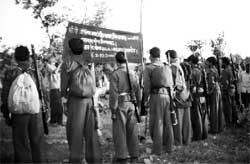Looking Back
 CHANGING
CHANGING
On March 2, 1967, Bimal Kesan, a tribal peasant of Naxalbari in West Bengal did something unimaginable: he obtained a judicial order to plough his own land. The landlords who were occupying his land attacked him. That was the birth of the Naxalite movement. A lot has changed over the years: the movement started with land alienation issue and subsequently took up forest and other related issues. The traditional bow and arrow has been replaced with AK-47s. Now, the guns are directed against the forest department officials and police, instead of the landlords.
Dipankar Bhatacharya, general secretary of the CPI(ML)(Liberation), the first party of the Naxalites, says that there are two groups emerging from the Naxalites movement: the People's War Group (PWG) which still adopt the old strategy of enemy annihilation. And the second group like the CPI (ML) Liberation that participates in elections. Barring some places, Naxalites are taking up more and more forest-related issues in their campaign. "The movement is a people's movement and issues of natural resources are of prime importance to the people. So the movement can't ignore it,' says Bhattacharya.
The predominance of violence in the movement is also working against the groups' people mobilisation efforts. "Continuance of violence will derail the movement,' says Bhattacharya. "It is also becoming less participatory as top leaders are losing contact with the cadres,' says Kodandaram Reddy, a professor at Nizam College, Hyderabad. In a confidential circular in 1998, the PWG admitted the possible alienation of people from the movement by
Related Content
- Energy security and the green transition
- The order of the National Green Tribunal regarding setting up of a ethanol plant at village Banana, cuttack district, Odisha, 12/06/2023
- Report filed by the Principal Chief Conservator of Forests, Punjab on illegal axing of trees in Ludhiana, 01/06/2023
- Powering social infrastructure in Sierra Leone: market assessment and roadmap for health facilities
- Powering social infrastructure in Sierra Leone: market assessment and roadmap for Schools
- Key indicators for Asia and the Pacific 2022
